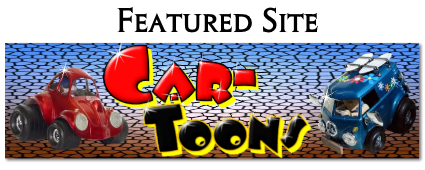Post by rocketeer on Nov 23, 2010 21:44:53 GMT -6
I just got done playing around with MicroMark's home photoetching system. Flushed with success, I posted my experience over at a sci-fi model site, but I thought you guys might be interested, too. So here's what I posted over there, edited slightly:
One of the guys in the local sci-fi club had been messing around with MicroMark's home photoetching system, and getting pretty good results. So when my Land Ironclad project needed some little teensy bits, I sprung for the photoetching kit. Today a snowstorm has immobilized everybody and I had a day at home to mess with it.
The kit is very complete; it even includes goggles and rubber gloves, in addition to all the supplies and chemicals you need. The instructions are a bit daunting, but very complete and clear, and after you've done it a couple times you kind of get the hang of it and things go pretty well.
After you've made your art, you print it onto transparency film. You heat-laminate a photoresist film (the laminating machine is included) onto brass sheet, then make an art-brass-art sandwich and expose it to a good strong light. You then dunk your exposed brass into a dilute sodium hydroxide solution to "develop" the photoresist, and then it goes into a tank with ferric chloride. The ferric chloride is agitated by a little air pump (also included), and after maybe ten or fifteen minutes, Voila!
But it takes a little practice. My first try I didn't develop the photoresist enough and no etching occurred. My second etched okay, but I left it in too long and the slenderer bits got etched completely away. My third "sandwich" I didn't expose to light long enough. But the fourth turned out very well.
One thing I learned is to etch similar things together. My initial fret had some slender bits (horse legs) and some bulky bits (armored window shutters), and by the time the shutters were done, the horse legs had disappeared. So for my fourth and final time, I cut my fret into parts, one with the horses, one with the shutters, one with the men, etched each one separately, and got much more controllable results.
I also learned that it goes pretty quick near the end, and that a minute means the difference between "just right" and "etched too much"--so when the part is nearly done etching, you want to pull it out of the solution every minute or so and look it over.
So, results:
My art and my second-try results (you can see that the shutters at the top got etched too much, and are rounded and misshapen instead of crisply rectangular):
i193.photobucket.com/albums/z256/hilbyf/Land%20ironclad/DSCN3514.jpg
My fourth try:
Armored shutters for the pilothouse (the model is 1/350 scale, so these are pretty tiny; maybe 0.10 inch on a side):
i193.photobucket.com/albums/z256/hilbyf/Land%20ironclad/DSCN3516.jpg
Shields for aftermarket cast-metal guns:
i193.photobucket.com/albums/z256/hilbyf/Land%20ironclad/DSCN3520.jpg
...and horses (I'll bulk them out with a bit of white glue):
i193.photobucket.com/albums/z256/hilbyf/Land%20ironclad/DSCN3522.jpg
One of the guys in the local sci-fi club had been messing around with MicroMark's home photoetching system, and getting pretty good results. So when my Land Ironclad project needed some little teensy bits, I sprung for the photoetching kit. Today a snowstorm has immobilized everybody and I had a day at home to mess with it.
The kit is very complete; it even includes goggles and rubber gloves, in addition to all the supplies and chemicals you need. The instructions are a bit daunting, but very complete and clear, and after you've done it a couple times you kind of get the hang of it and things go pretty well.
After you've made your art, you print it onto transparency film. You heat-laminate a photoresist film (the laminating machine is included) onto brass sheet, then make an art-brass-art sandwich and expose it to a good strong light. You then dunk your exposed brass into a dilute sodium hydroxide solution to "develop" the photoresist, and then it goes into a tank with ferric chloride. The ferric chloride is agitated by a little air pump (also included), and after maybe ten or fifteen minutes, Voila!
But it takes a little practice. My first try I didn't develop the photoresist enough and no etching occurred. My second etched okay, but I left it in too long and the slenderer bits got etched completely away. My third "sandwich" I didn't expose to light long enough. But the fourth turned out very well.
One thing I learned is to etch similar things together. My initial fret had some slender bits (horse legs) and some bulky bits (armored window shutters), and by the time the shutters were done, the horse legs had disappeared. So for my fourth and final time, I cut my fret into parts, one with the horses, one with the shutters, one with the men, etched each one separately, and got much more controllable results.
I also learned that it goes pretty quick near the end, and that a minute means the difference between "just right" and "etched too much"--so when the part is nearly done etching, you want to pull it out of the solution every minute or so and look it over.
So, results:
My art and my second-try results (you can see that the shutters at the top got etched too much, and are rounded and misshapen instead of crisply rectangular):
i193.photobucket.com/albums/z256/hilbyf/Land%20ironclad/DSCN3514.jpg
My fourth try:
Armored shutters for the pilothouse (the model is 1/350 scale, so these are pretty tiny; maybe 0.10 inch on a side):
i193.photobucket.com/albums/z256/hilbyf/Land%20ironclad/DSCN3516.jpg
Shields for aftermarket cast-metal guns:
i193.photobucket.com/albums/z256/hilbyf/Land%20ironclad/DSCN3520.jpg
...and horses (I'll bulk them out with a bit of white glue):
i193.photobucket.com/albums/z256/hilbyf/Land%20ironclad/DSCN3522.jpg




